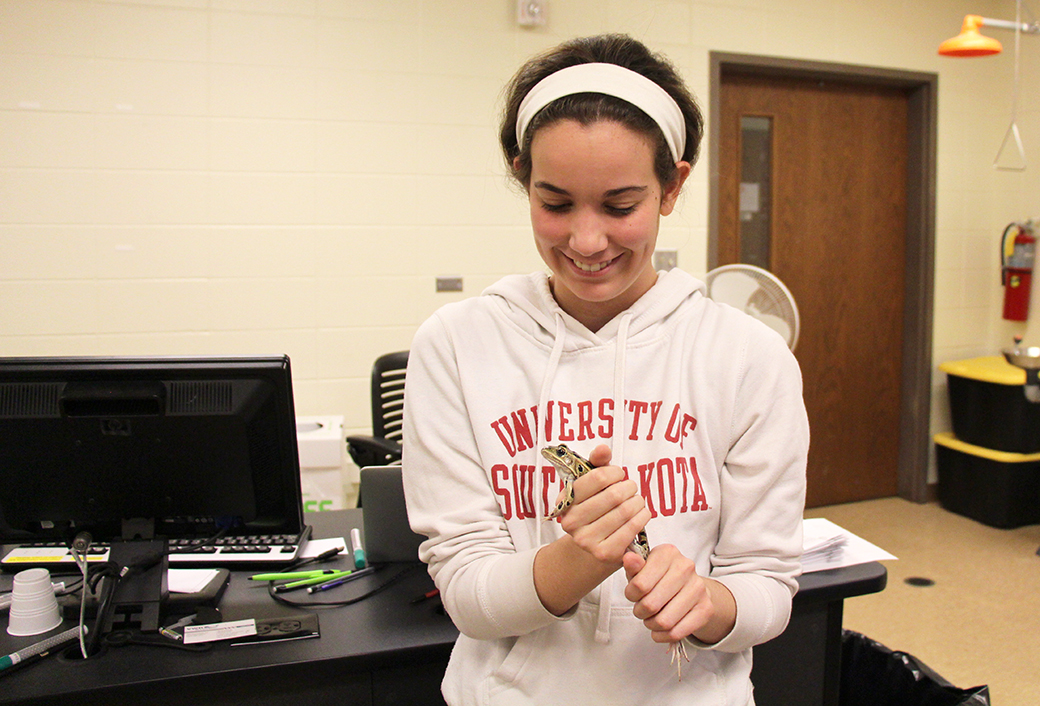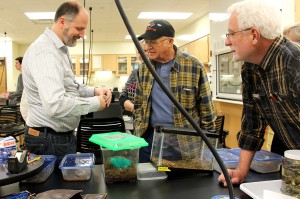
FrogWatch USA training aims to save frogs
By Natalie Keller and Megan Card
A way to remember the sound of an American bullfrog: imagine the pulsating buzz of a “lightsaber.” This may seem to be an unusual comparison, but for Jake Kerby, it is a way to turn the young and old into “FrogWatch Citizen Scientists.”
Kerby, a biology professor at the University of South Dakota, led the second FrogWatch USA training event in Vermillion Saturday afternoon in Churchill Haines.
The three-hour training session taught attendees 12 regional frog calls, how to identify them and complete a survey to enter data collected in wetland locations.
“The method is pretty simple. You basically go to a wetland after dark, 30 minutes after dusk. You sit quietly for two minutes and listen to frog calls for three minutes and you just write down what you hear,” Kerby said.
FrogWatch USA is a national organization with individual chapters around the country. The local group led by Kerby is the Great Plains chapter and covers the South Dakota, Nebraska and Iowa area. Members include students from USD and South Dakota State University as well as community members from around the region.
Ever since he was five years old, USD graduate student Spencer Siddons has been interested in biology. He is getting firsthand experience
 in getting others excited as well through FrogWatch USA training.
in getting others excited as well through FrogWatch USA training.
“I was just kind of the typical kid that liked frogs and snakes and nature,” Siddons said. “It just stuck with me, and I realized I could make a career out of it.”
Siddons assisted Kerby Saturday to teach the correct protocol to collect data and where to enter it online. Attendees also completed an exam on the various frog calls. All nine in the class passed and were given certificates to verify they have the necessary skills to go out on their own and collect frog and toad data to enter in national databases.
Kerby said the information gathered by these “citizen scientists” is important because it allows educators and biologists to track where the frogs are and if they are still in the area or disappearing.
“Amphibians worldwide are on a massive decline so we kind of know biodiversity loss is a big thing, but as it turns out, amphibians are the most threatened,” Kerby said.
Thirty-three percent of amphibian species are threatened by extinction, he said. A number of reasons are attributing to their incline, such as pesticides and diseases.
[notification type=”information” title=”Reasons why amphibian species are declining:”]1. Habitat destruction 2. Global climate change 3. Invasive species 4. Emerging diseases 5. Emerging contaminants[/notification]
Kerby said amphibians play a big role in the environment and are critical components of an ecosystem. If amphibians go extinct, the food chain will be disrupted and the whole ecosystem will change, he said.
Amphibians also control the insect population and keep pests away that carry and pass on diseases, Siddons said. But, he said the training does more than teach basic facts about frogs and toads.
“Just building connections with amphibians in a way that helps people realize that they are important and they have some interest to them by just being able to identify their call,” Siddons said. “You kind of build a stronger bond the more you learn about something.”
Kalie Leonard, a first-year biology major who participated in the training, said the data is important for researchers so they can continue their research on frog declines.
“They’re called an indicator species,” Leonard said. “If they’re declining, then there’s something wrong with the ecosystem that they’re in.”
Leonard said students will benefit by learning more about frogs.
“They will definitely be helping out frogs,” Leonard said. “You get to learn what different frogs sound like. Sometimes when you’re outside you think you’re hearing birds, but they’ll actually be frogs. So then (students) can be more informed.”
Toni Merchen traveled across the South Dakota state line for the training. The Nebraska resident has a part-time job this summer as a naturalist. She hopes to be able to lead some evening or night hikes near her home to use her new frog call skills.
The husband and wife duo of Mike and Nancy Varondeau of Roscoe, S.D., also completed training. The two are both retired teachers, which was part of their reasoning for wanting to know more about the environment around them, particularly in the wetlands.
“We can identify most bird sounds when we go hiking, and before this class, we couldn’t distinguish a frog from a toad, or one species of frog from another,” Nancy Varondeau said. “Now, we know at least 12.”
Kerby admits it can be difficult for someone like himself, who has studied amphibians for years, to distinguish frogs and toads merely by seeing them, which is why listening is such a crucial part of the training. While it might also be difficult at first for the new “FrogWatch Citizen Scientists” to start their own data collection, he did at least leave the class with some parting wisdom about the consumption of frogs and toads.
“If you end up on a reality TV show in the wilderness, take away at least this from the class: Don’t eat anything brightly colored and slow moving,” Kerby said.
(Photo 1: First-year Kalie Johnson grips on to a frog during FrogWatch USA training Saturday in Churchill Haines. Megan Card/The Volante)
(Photo 2: Professor Jake Kerby, left, holds a frog up for FrogWatch USA participants during their training session Saturday afternoon. Megan Card/The Volante)
